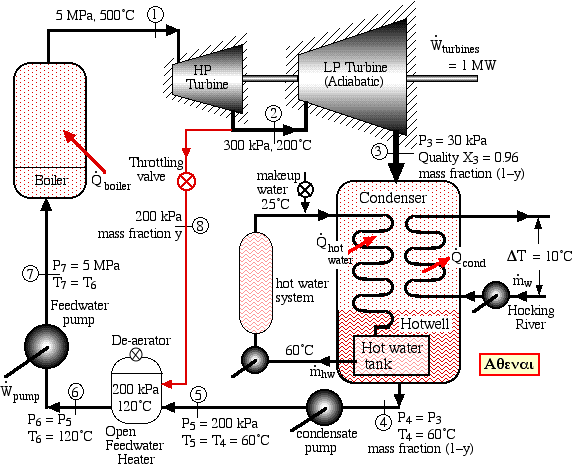
Problem 8.2 - A Cogeneration Steam Power Plant with an Open Feedwater Heater
Cogeneration or Combined Heat and Power (CHP) is the utilization of 2 forms of energy from 1 source i.e.: hot water/heat and electricity from one gen-set.
According to the American Council for an Energy Efficient Economy (ACEEE), the world's first commercial power plant - Thomas Edison's Pearl Street Station built in 1882 - was a cogeneration plant as it made and distributed both electricity and thermal energy, thus the concept has been around for many years, With the recent interest in greener energy technologies it is currently becoming more popular.
This brings us to the current problem statement:- In an effort to decentralize the power grid and utilize the waste heat which accompanies power generation, Athenai Power Consulting have proposed a cogeneration system for Ohio University to provide both 1MW electric power and hot water at around 60°C. They realise that the power consumption of OU is much higher, however they believe that a significant portion of this power is required for hot water heating.
The basic approach to this unique design is shown in the following schematic diagram:
A unique aspect of the power plant is that the hot water storage tank is located in the hotwell of the condenser allowing direct heating and storage of the water at the required temperature of 60°C with no heat loss. The continuous supply of hot water is pumped from the storage tank through the hot water distribution system in the various buildings, and makeup water is added as required. Notice that in order to ensure continuous condensation of the steam there is a parallel cooling system using water pumped from the Hocking River which can be controlled as needed based on the hot water heating requirement Notice also that Athenai have proposed an Open Feedwater Heater / De-aerator in an attempt to improve the efficiency of the basic design.
As a young engineer at Athenai your purpose is to complete the design and evaluate and discuss its effectiveness.
a) Neatly sketch the complete cycle on the P-h diagram provided, indicating clearly all the stations (1) through (8) on the diagram.
b) Using the Steam Tables determine the enthalpy values at each of the (8) stations. Indicate the values obtained on the P-h diagram and check them for feasibility.
c) Determine the mass fraction y of the steam bled from the outlet of the HP turbine at station (2) in order to heat the water in the de-aerator to 120°C. [y = 0.097]
d) Determine the mass flow rate of the steam required to provide 1 MW of output power from both turbines [1.15 kg/s].
e) Determine the power required to drive the feedwater pump [5.5 kW].
f) Determine the overall thermal efficiency [ηth] of this power plant. (Recall that thermal efficiency is defined as the net work done divided by the total heat supplied externally to the boiler.) [30%]
g) Determine the cooling power in the condenser required to condense the steam exiting the turbine at station (3), and to subcool the condensed liquid in the Hotwell to 60°C at station (4) [2.62 MW].
h) In the event that the hot water system is not operating, determine the mass flow rate of the river water required such that it will not experience a temperature rise of more than 10°C as it passes through the condenser [62.7 kg/s].
i) Neatly sketch the turbine processes (1)-(2)-(3) on the h-s diagram provided. Plot also the isentropic turbine processes on the diagram, and indicate the actual turbine specific work as well as the isentropic turbine specific work for both turbines on the h-s diagram. Using the Steam Tables determine the turbine adiabatic efficiency [ηT] for both turbines. [80%, 84%].
j) Discuss the proposed system with respect to its environmental impact and feasibility.
Justify all values used and derive all equations used starting from the basic steady flow energy equation, the enthalpy difference [Δh] for an incompressible liquid, the basic definition of thermal efficiency [ηth] of a heat engine, and the definitions of adiabatic efficiency [ηT] of a turbine.
______________________________________________________________________________________